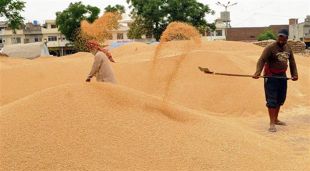
Farm officials claim that there are no reports of yellow rust on wheat plants. Tribune photo
Tribune News Service
Moga, January 22
Intermittent showers lashed most parts of the state, including the Malwa belt, in the past 24 hours. Experts said rain at this point of time was beneficial for wheat, mustard and rabi crops.
While Moga received an average of 10 mm of rainfall, most parts of Ferozepur district received 8 mm of rainfall today.
There are also reports of rain in Faridkot, Muktsar, Bathinda, Mansa, Fazilka, Barnala, Sangrur and Ludhiana districts.
Director of Met Department, Chandigarh, Surender Paul said Pathankot received the highest rainfall (90 mm), Tibri in Gurdaspur (80 mm), Jalandhar (50 mm), Mukerian in Hoshiarpur district (70 mm) and Adampur in Jalandhar (60 mm).
Amritsar recorded 13.1 mm of rainfall, Ludhiana 50 mm, Patiala 15 mm, Halwara 40 mm, Bathinda 4 mm, Faridkot 2.2 mm, Ropar 20 mm, Khanna 10 mm, Fatehgarh Sahib 10 mm, Sangrur 10 mm, Tarn Taran 10 mm and Muktsar 10 mm, he said.
The Met has predicted rainfall at isolated places in the next 48 hours and heavy rainfall on January 25 and 26. Dry weather has been predicted after January 26, leading to a drop in minimum temperatures by 4 to 5 degrees Celsius.
The minimum temperature in the region was 5 to 7 degrees Celsius above normal. In Moga, it was 9 degrees Celsius last night, five notches above normal. In Ludhiana, it was 9.2 degrees Celsius and in Ferozepur 8.5 degrees Celsius. Patiala recorded 12 degrees Celsius.
Meanwhile, the rain has brought cheer to farmers as the weather is favourable for crops like wheat, sugarcane, mustard and peas. Rain has eliminated the frost from potatoes and peas.
Dr Jaswinder Singh Brar, a farm expert, said the widespread rain had increased soil moisture, required for the development of wheat plant at this stage. “Since rain is the best source of natural nitrogen, it increases the nutrient uptake efficiency of the plants,” he said.
The farmers are busy sprinkling the second dose of urea on the wheat crop. Rain is likely to boost the growth of plants.
Farm officials in Moga and its adjoining districts claimed that that there were no reports of yellow rust on wheat plants, which was also a good sign for the farmers. Increased photosynthesis means good wheat crop.



























